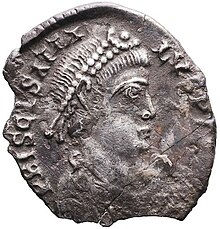409
Appearance
This article needs additional citations for verification. (October 2017) |
| Millennium: | 1st millennium |
|---|---|
| Centuries: | |
| Decades: | |
| Years: |
| 409 by topic |
|---|
| Leaders |
| Categories |
| Gregorian calendar | 409 CDIX |
| Ab urbe condita | 1162 |
| Assyrian calendar | 5159 |
| Balinese saka calendar | 330–331 |
| Bengali calendar | −184 |
| Berber calendar | 1359 |
| Buddhist calendar | 953 |
| Burmese calendar | −229 |
| Byzantine calendar | 5917–5918 |
| Chinese calendar | 戊申年 (Earth Monkey) 3106 or 2899 — to — 己酉年 (Earth Rooster) 3107 or 2900 |
| Coptic calendar | 125–126 |
| Discordian calendar | 1575 |
| Ethiopian calendar | 401–402 |
| Hebrew calendar | 4169–4170 |
| Hindu calendars | |
| - Vikram Samvat | 465–466 |
| - Shaka Samvat | 330–331 |
| - Kali Yuga | 3509–3510 |
| Holocene calendar | 10409 |
| Iranian calendar | 213 BP – 212 BP |
| Islamic calendar | 220 BH – 219 BH |
| Javanese calendar | 292–293 |
| Julian calendar | 409 CDIX |
| Korean calendar | 2742 |
| Minguo calendar | 1503 before ROC 民前1503年 |
| Nanakshahi calendar | −1059 |
| Seleucid era | 720/721 AG |
| Thai solar calendar | 951–952 |
| Tibetan calendar | 阳土猴年 (male Earth-Monkey) 535 or 154 or −618 — to — 阴土鸡年 (female Earth-Rooster) 536 or 155 or −617 |

Year 409 (CDIX) was a common year starting on Friday of the Julian calendar. In the Roman Empire, it was known as the Year of the Consulship of Honorius and Theodosius (or, less frequently, year 1162 Ab urbe condita). The denomination 409 for this year has been used since the early medieval period, when the Anno Domini calendar era became the prevalent method in Europe for naming years.
Events
[edit]By place
[edit]Roman Empire
[edit]- Spring – Gerontius, Roman general (magister militum), who had been a partisan of Constantine III, revolts in Hispania. He elevates Maximus, his domesticus, as emperor.
- October 13 – The Vandals, led by King Gunderic, cross the Pyrenees into the Iberian Peninsula. They receive land from the Romans, as foederati, in Baetica (Southern Spain). The Alans occupy lands in Lusitania and the Suebi control parts of Gallaecia.
- The Visigothic king Alaric I lays siege to Rome a second time, bringing the inhabitants close to starvation. Emperor Honorius, safe in inaccessible Ravenna, refuses to negotiate for peace, despite repeated offers from Alaric, who then comes to terms with the Senate and sets up a rival emperor, Priscus Attalus, prefect (praefectus urbi) of the city.
- Honorius agrees that sons of prominent families at court in Ravenna be sent beyond the Danube as hostages; in return, later he calls up ten thousand Hun mercenaries.[1]
- Famine strikes Hispania, Gaul and the Italian Peninsula.[citation needed]
- Bacaudic Rebellion: Peasants in Armorica, northwestern Gallia launch a revolt. The unrest continues until 417.[2]
Asia
[edit]- Mingyuan, age 17, succeeds Daowu as emperor of the Chinese Northern Wei (one of the Northern dynasties).
- Battle of Linqu: Southern Yan is defeated by Eastern Jin.
Births
[edit]- Daniel the Stylite, Christian saint (approximate date)
- Liu Yikang, prince of the Liu Song Dynasty (d. 451)
Deaths
[edit]- Daowu, emperor of the Northern Wei (b. 371)
- Gao Yun, emperor of the Northern Yan
- Li of Yan, empress, wife of Gao Yun (who died the same year)
- Mallius Theodorus, Roman consul (approximate date)
- Serena, noblewoman and wife of Stilicho
References
[edit]- ^ The End of Empire (p. 56). Christopher Kelly, 2009. ISBN 978-0-393-33849-2
- ^ Burns, Vincent (1992). "The Visigothic Settlement in Aquitania: Imperial Motives". Historia: Zeitschrift für Alte Geschichte. 41 (3): 362–373. ISSN 0018-2311. JSTOR 4436252.
